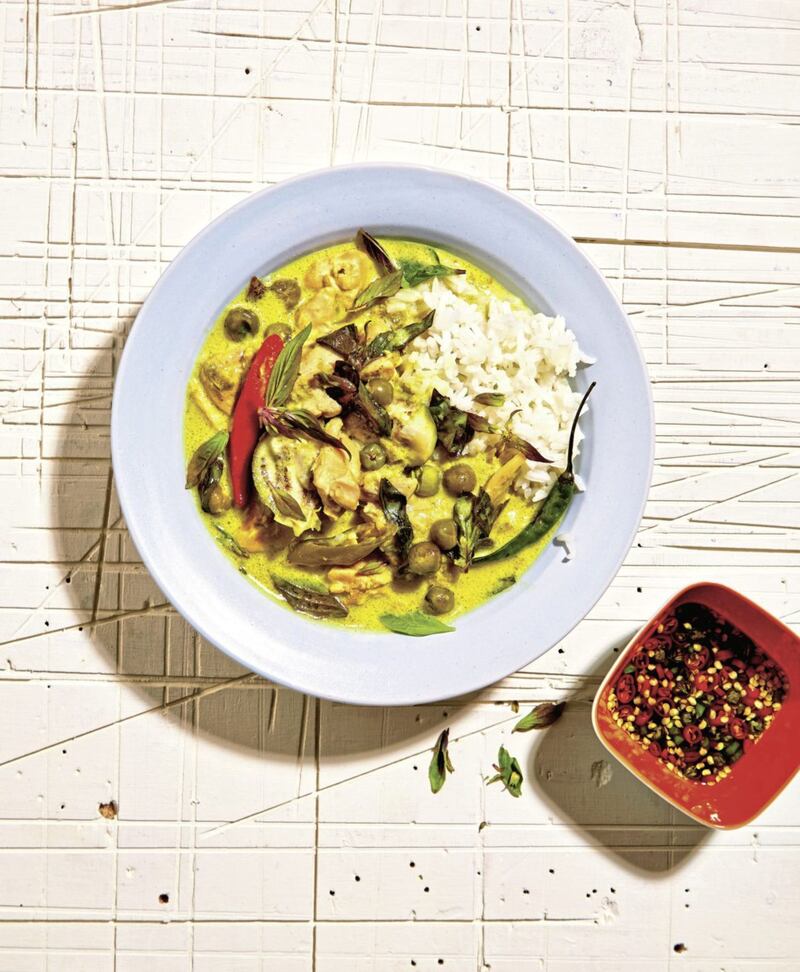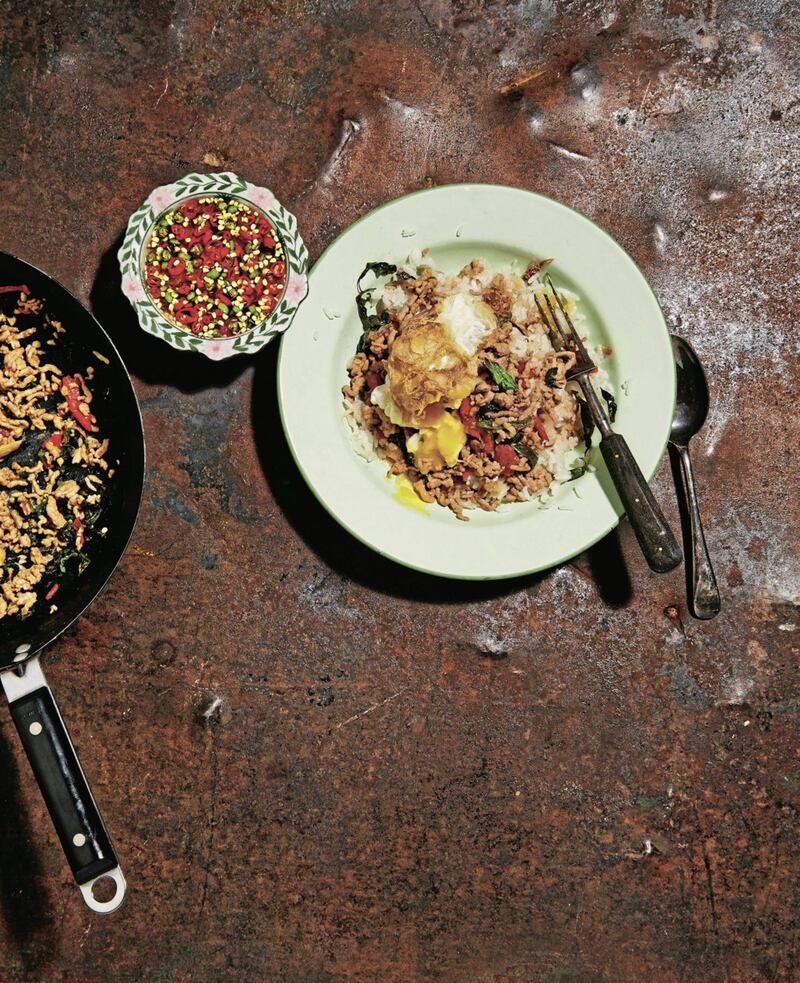FOR a decade, Kay Plunkett-Hogge has patiently been writing and co-authoring cookbooks with the likes of Leon and actor Stanley Tucci ("He's wonderful, we had a hoot").
But however exciting those other projects were, all that time, a cookbook of the Thai food she grew up eating was formulating in her mind. "Baan is the book I started food writing to write," the columnist, food consultant and cookery teacher explains, looking brilliantly glam over coffee in a tiny Italian cafe in south-west London.
Plunkett-Hogge was born in Thailand in 1964 – "just as the Vietnam war was really gearing up" – and raised in Bangkok, where her father, who worked for Ford Motors and "had the gift of the gab", was transferred in 1961 to sell tractors. "They sent him for two years and he ended up staying 35."
She spoke Thai before English, and returned to the UK for boarding school aged 11 – which, admittedly, was a shock: "I had to wear shoes – didn't like that", and the food, she recalls, was "devastating". She'd go home to Thailand two or three times a year, and still does.
Calling her childhood "incredibly idyllic", Plunket-Hogge, now 55, spent much of it between her family's two kitchens: Inside for Western food (where the fridge and freezer reigned supreme); outside for Thai (all polished concrete floors and charcoal burners). Her mum and their family cook, Prayoon, would teach each other about their cuisines, while Plunkett-Hogge toddled greedily from one to the other. "I was very chubby because I'd eat about 10 meals a day," she says with a laugh. "I was in and out all the time."
Between the array of dinners and her menagerie of animals ("I had 20 cats at one point, I had pygmy owls, flying squirrels, chipmunks, my dad had a falcon and a hawk in the aviary in the back garden, a crow, ducks, geese, a civet cat..."), 'idyllic' doesn't seem to quite do it justice. She was, she adds, "so spoilt."
Fragments of her early years in Thailand spill across Baan (which means 'home'), where the pages, ablaze in 70s Technicolor, are strewn with family photos. The recipes themselves are a patchwork map of memory, friendship and shared culinary love, from her ultimate comfort dish of prad kapow moo (pork stir-fried with holy basil) to her godmother Shirley's soi thonglor ribs, that would always be accompanied by a scary film and "large and potent" G&Ts.
Plunkett-Hogge is pragmatic when it comes to people's potential fears around attempting Thai food for the first time. "It's not Thai food made simple," she explains. "I try and demystify it slightly." Your main obstacle, she says, is prepping everything, "but once you've got that done, the rest of it's quick, and a curry's a doddle."
It helps that, despite owning numerous pestle and mortars (and no fewer than seven woks "all for different things, and the cheapest ones are the best"), she's all for buying curry pastes.
"You don't have to make a curry paste from scratch, none of my Thai friends do," she says. "They go to the market every morning and buy their favourite vendor's paste, or they buy the Nittaya brand."
Making your own only makes sense if "you're in a village and have got no choice", or if you're making her "damn fine" green curry. "If you're going to make any from scratch, make that one."
On the topic of Thai green curries, she is firm. The "sweet, mild green thing" you're usually served in British takeaways is not how it should be. "If you had the real thing, you're just like, 'Wow'," says Plunkett-Hogge. "It's a weirdly complex dish, a lot of prep, a lot of ingredients, and when you have a good one, it's really good – you can tell the difference.
"It shouldn't have any sugar in it; it's not a sweet curry, and it's one of the hottest."
She has similarly strong views on street food. "If it's not on the street, it's not street food – you can make something similar at home, but you're never going to have that fierce wok flame, you're never going to have the expertise of the guy who does it every single day for 30 years, like my guy who makes chicken and rice. Thirty-five years on the same spot, from 6am to 3pm, just one dish!"
You can't help but be convinced by her. And as an expert on boozing – she's authored drinks books Make Mine A Martini and Aperitvo – she's also to be trusted on Thailand's drinking culture, which happens to revolve around food.
"There's a tradition of having food to stop you getting drunk, so there's lots of little snacky things to have while you're drinking," she says, conjuring the image of cramming handfuls of spicy nibbles into your mouth between sips of beer, which is normally served with ice in it: "It's a very nice local way of drinking, especially in the heat."
Thai food is still on the menu in her London home two or three times a week (she couldn't live without deep-fried eggs).
"Luckily my husband likes Thai food," says Plunkett-Hogge with a cackle. "We always said if he didn't, there wouldn't have been a second date."
:: Baan: Recipes And Stories From My Thai Home by Kay Plunkett-Hogge, photography by Louise Hagger, is published by Pavilion Books, priced £20. Below are two recipes from the book for you to try.

CLASSIC GREEN CHICKEN CURRY
(Serves 4)
For the paste:
1/2tsp coriander seeds
1/2tsp cumin seeds
1tsp white peppercorns
A good pinch of salt
1tbsp finely chopped galangal
1tbsp finely chopped lemongrass
2 Thai shallots or 1 regular shallot, peeled and finely chopped
12 green Thai bird's eye chillies, de-stemmed and chopped
2 long green chillies, de-stemmed and finely chopped
4tbsp finely chopped fresh coriander root, with some stem attached
1 garlic clove, peeled and finely chopped
2cm piece of fresh turmeric, finely chopped
Zest of 1 kaffir lime
1tsp kapi (shrimp paste)
For the curry:
2tbsp vegetable oil
1 x 400ml can of coconut milk
350g chicken thighs, cut into 2cm dice
1-2tbsp nam pla (fish sauce)
A pinch of caster sugar (optional)
65g pea aubergines (these are available from Amazon and certain supermarkets)
2 Thai round aubergines , cut into quarters
100g bamboo shoots, chopped (canned or vacuum-packed)
2 long red chillies, diagonally sliced into 3 pieces
A large handful of Thai sweet basil
1 long orange chilli (optional)
Method:
To make the paste: Pound all the ingredients in a pestle and mortar (starting with hardest ingredients first, as listed, working down to the softest), until you have a uniform, close-textured paste.
To make the curry: Heat the oil in a wok or saucepan and fry the paste until it smells fragrant, about one minute. Add half of the coconut milk, bring to the boil slowly. Once the paste has dissolved, let the coconut milk simmer a little until you see oil appearing on the surface. Then add 200ml of water and bring to the boil.
Add the chicken and bring back to the boil, then add the rest of the coconut milk. Bring back to the boil and simmer for about six minutes. Add the nam pla and the sugar, if using. Taste and adjust the seasoning. If it seems a little thick, add a little more water – you want a soupiness.
Add the aubergines, the bamboo shoots and one of the long red chillies. Simmer for another three minutes or so. Add the basil, the remaining red chilli and the whole orange chilli if you have one, and serve with some jasmine rice and Nam Pla Prik (Fish Sauce with Chillies).
Note: If you can't find coriander root replace it with the same amount of coriander stem.

PORK STIR-FRIED WITH HOLY BASIL
(Serves 2)
4-6 Thai bird's eye chillies
1 large red chilli, cut into chunks
6 garlic cloves, peeled
a pinch of sea salt
2tbsp dark soy sauce
2tbsp light soy sauce
A pinch of caster sugar
2tbsp vegetable oil
300g pork, minced
100g green beans, topped, tailed and cut into 1cm pieces
A very large handful of holy basil leaves
Method:
In a pestle and mortar, pound the chillies, garlic and salt to a rough paste. Set aside. In a small bowl, mix the soy sauces and two tablespoons of water, and stir in the sugar.
Heat a wok until really hot, then add the oil. Throw in the chilli-garlic paste and stir-fry for a few seconds – until you can really smell everything in the pan, but not long enough to colour the garlic. Now add the pork and stir-fry until it's cooked through, then add the green beans.
Add the liquid and stir through, allowing it to bubble up before adding nearly all the basil and letting it wilt into the dish.
Serve over steamed jasmine rice, with Kai Dao (deep-fried eggs), and the remaining basil leaves scattered on top. (To make deep-fried eggs, in a small wok heat 300ml of vegetable oil until it's as hot as you dare. Then, crack in an egg – be careful, it will split – and cook, basting in the oil, until the white is crispy at the edges but the yolk within remains runny. Set aside on paper towels until ready to eat.)
If you can't find holy basil (bai krapow), use Thai sweet basil instead. Worst-case scenario, use regular basil.



